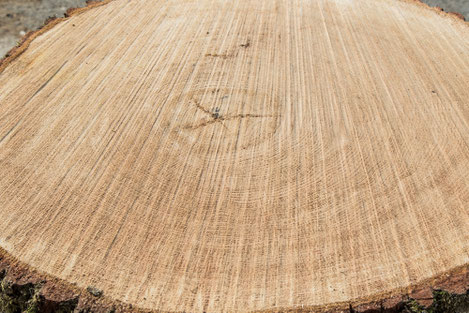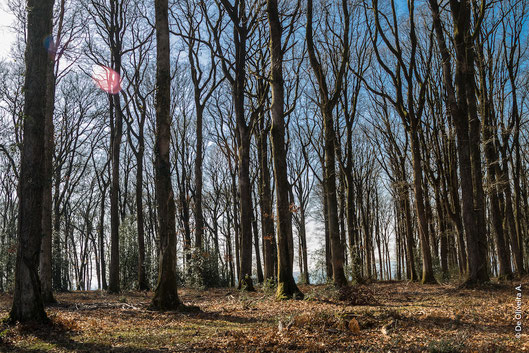Adeline has been working with us for a little more than 4 weeks now. Her internship will end today and before she leaves, we wanted to give her the opportunity to introduce her family's company on our blog.
"merrandiers" from generation to generation

In this article, I will tell you about the job of “merrandier” in France, and more specifically about the company Merrain Camille Gauthier located in Méry-ès-Bois in the Cher region.
Originally from Limousin, my grandfather settled in the center of France with his wife Jacqueline and their two children, Nathalie and Ludovic. He founded his company, Merrain Camille Gauthier, i3n 1979. But why did he leave his native region to come to the centre of France? This area is a natural forest region, so we are surrounded by forests! The village of Méry-ès-Bois is at the heart of various forests such as St Palais, Allogny and Vierzon or Tronçais and Bercé, which are well-known. The company now has two separate mills, one in the Cher department and the second in the village of Taponnat in the Charente department.
What does a "merrandier" do?

The “merrandier” 's work consists in splitting wood while following the medullary rays of the wood (see photo). “Merrain” is the raw material while the finished product, the rectangular blade, is called a stave. Staves are the essential parts of the barrel. Throughout the manufacturing process, it is essential to follow the grain of the wood, as it is what will give a quality stave and a watertight barrel. What is the grain of the wood? It refers to the direction of the fibers of the tree. To make a stave, it is important to respect this grain throughout. The closer the fibers, the finer the grain of the wood.
From the tree to the stave
The oaks are felled in winter, during the sap-free period. Then the timbers, called logs, are transported to the stave mill, where they are watered to protect them from insect bites. The first step is to cut the logs into one-meter parts. These logs are then split into quarters while respecting the grain of the wood. Then there are different steps to turn these quarters into staves of a defined thickness and length. The last step is to control and sort the staves one by one to check their quality. Some faults have to be avoided, such as nodes – which correspond to the location of a branch. The criteria to make a barrel are demanding: on average, 80% of the raw material is actually lost.
Throughout this whole process, Merrain Camille Gauthier sets a very precise traceability which, at each stage, allows to know the source of the wood. When the stave piles are delivered to the cooper, they bear a number which allows to trace the exact route of the wood and thus to determine its origin.
The raw material: French oak

In the manufacture of staves, the raw material is oak. Depending on the species, the wood is different. In Europe, sessile oaks grow slowly and therefore have a fine grain while pedunculate oaks grow faster, resulting in a larger grain. Sessile oaks are suitable for wine while pedunculate oaks are better suited for Cognac. European oaks are commonly used to age wine; as for American oaks, richer in tannin, they are better for the ageing of spirits.
In France, the majority of stave-quality oaks are sold in batches by the “Office National des Forêts”. Each French forest is comparable to a wine terroir: depending on the region, each forest varies, and its wood will therefore not provide the same properties to the barrel. At Merrain Camille Gauthier, it is a know-how that is highlighted and shared with the winemakers so that they can choose the forest that best matches their wine.
Our customers: coopers and winemakers

After natural drying - from 18 to 36 months - the staves leave for the cooperages where they are assembled to make barrels. The merrandiers' main customers are therefore the coopers, but they are not the only ones. As explained above, each forest has its own terroir, so they also work with winemakers to find the forest or region best suited to their wine. The "taste" of a barrel also depends on its toasting: in fact, coopers have a real know-how when they have to determine the time and intensity of the toasting process.
It is important to work closely together to offer the customers exactly what they look for. Today, Merrain Camille Gauthier works both with French and foreign customers. Wine-making regions are now widespread all over the world, which means that the market for barrels and therefore staves is as well.
Ancient skills and methods
In this video, Camille Gauthier, my grandfather, shows how staves were split and made when he started in this trade. Everything was done in the forest. It was only when machines were introduced that the stave mills were created. Camille then passed on his knowledge to his grandson Vincent.
The development of alternatives

Vincent Le Mouël, my brother, studied forestry and started his own business, Vin’s Oak, a few years ago. He makes alternatives: these are small pieces of French oak wood that are meant to be dipped into the wine tanks. There are different alternative products, such as chips, dominoes or wooden slats. Each product will bring a more or less pronounced “taste” to the wine. His company is located in the Cher, in Neuvy sur Barangeon. He also highlights the traceability of the origin of his various products.



Write a comment